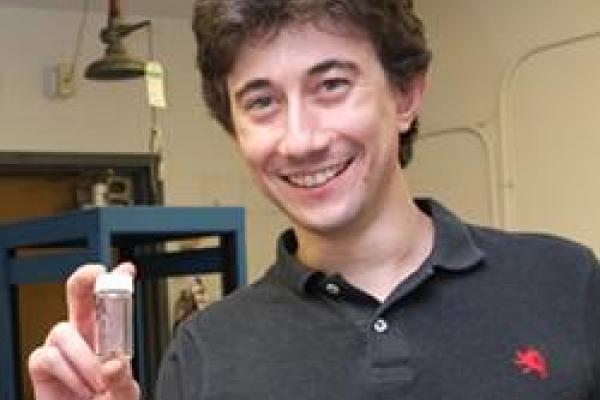STEAM Member Josh Goldberger Receives Camille-Dreyfus Teacher-Scholar Award

Article from the College of Arts and Sciences (http://artsandsciences.osu.edu) by Sandi Rutkowski
Chemist Recipient of Camille Dreyfus Teacher-Scholar Award — One of Only 13 Nationwide
Joshua Goldberger, assistant professor, chemistry and biochemistry, is the recipient of a 2015 Camille Dreyfus Teacher-Scholar Award. He joins an elite group — this year, only 13 — of the country’s top young researchers in the chemical sciences, who receive an unrestricted research grant of $75,000. Selection is based on establishing an independent body of scholarship within the first five years of their research careers and demonstrating a strong commitment to education. Goldberger has done both in full measure.
For Goldberger, being selected for a Camille Dreyfus Teacher-Scholar Award is both personally and professionally gratifying.
“It is great to have been recognized for not only the numerous research achievements from my lab, but my commitment to educating and mentoring the next generation of undergraduate and graduate students in the chemical sciences,” Goldberger said. “As a former OSU undergraduate, one of the major reasons that I decided to pursue a career in the field of chemistry was my research experience here; I am passionate about giving my students the same positive experience.”
The work in Goldberger’s lab, which focuses on learning how to design new materials that synergistically unite and organize inorganic and organic components for applications in energy conversion and medicine, certainly is being noticed, along with the success of his talented undergraduate researchers.
“Many times, these students make significant contributions to their advisor’s work,” Goldberger said.
Case in point: undergraduate chemistry major Elisabeth Bianco. In 2012, she won first place in a national nanotech competition and brought home a $3,000 prize for her exploration of the properties of a one-atom thick layer of germanium done in Goldberger’s lab. “Bianco actually spearheaded the project, synthesizing and characterizing germanium for the first time,” Goldberger said.
In September 2014, Goldberger became co-PI on a $2 million, four year study, funded by the National Science Foundation’s Division of Emerging Frontiers in Research and Innovation.
He heads a team looking at controlling and modulating the thermal conductance and thermoelectric properties of germanium and tin by manipulating the materials’ thermal properties on the atomic level.
“Research such as this pushes the study of heat transport to the atomic-size scale. And, I am pleased that the work of Bianco, now a graduate student at Rice University, led to further research of the ultrathin material by five senior researchers,” Goldberger said.
In related work funded through Ohio State’s Center for Emergent Materials, an NSF Materials Research Science and Engineering Center, Goldberger co-leads a team of chemists, electrical and computer engineers, materials science engineers and physicists from Ohio State, UC-Berkeley, and Case Western.
These leading experts in creating and manipulating single-atom sheets are studying Control of 2D and 1D Electronic Structure by Surface Functionalization of Group-IV Graphane Analogues. The flexibility of these new materials will find broader applications in science and technology including new opportunities in materials by design, platforms for chemical sensing and information processing.
Goldberger also works on dynamic self-assembling 0D/1D materials for medical imaging, seeking to exploit the superior properties of peptide nanomaterials to improve state-of-the-art medical diagnostic and therapeutics.
His long-term goal? To develop clinically translatable imaging agents that can selectively accumulate in cancer tissue, using self-assembling peptide materials that transform in the chemistry of the tumor microvasculature.
Right Now? “I am excited to be able to join a community of other distinguished teacher-scholars, which will give me opportunities to discuss research and novel approaches to teaching.
“Furthermore, this five-year unrestricted research grant will allow my lab to pursue exciting new ideas in materials research.”
Goldberger received his BS in chemistry from Ohio State in 2001 and his PhD in chemistry from the University of California at Berkeley in 2006, as an NSF graduate fellow. He then did postdoctoral research with Professor Sam Stupp at Northwestern University as part of the Institute for BioNanotechnology in Medicine, as an NIH-NRSA postdoctoral fellow (2007-2010). Among his many awards are an MRS Graduate Student Finalist Award in 2003, and an IUPAC Prize for Young Chemists in 2007.
He returned to Ohio State as an assistant professor in August, 2010, and now Ohio State’s Department of Chemistry and Biochemistry can boast 12 Camille Dreyfus Teacher-Scholars.
